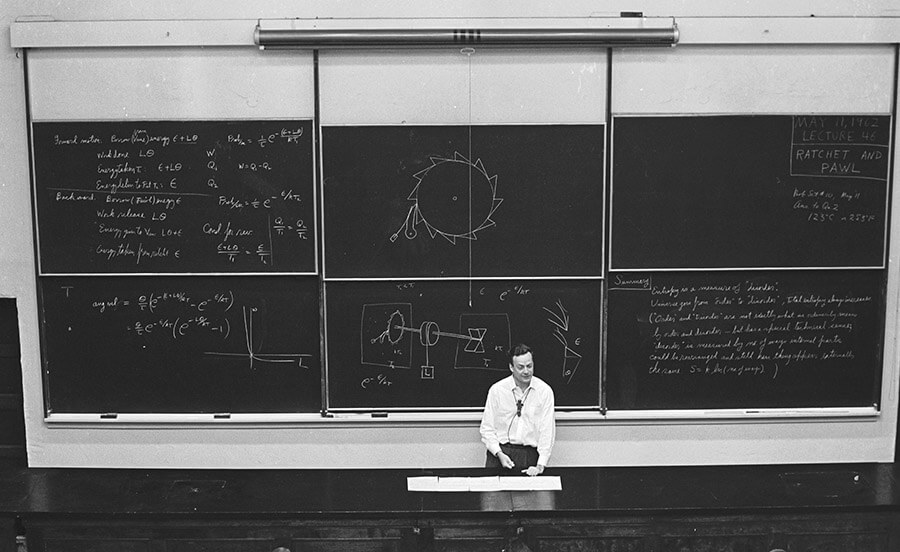How to unlock learning with the Feynman Technique
Learning is one of the most important skills we can master. Despite its importance, most of us never learn… how to learn.
In this post, I’ll cover the Feynman Technique, a method you can use to learn anything.
Introduction
Richard Feynman may have had one of the most curious minds in history. Feynman developed new theories in physics, nanotechnology, and quantum computing, winning a Nobel Prize in 1965. He was also known for his love of pranks, for which he developed a reputation while working on the Manhattan Project during WWII.

Feynman’s genius extended beyond science. An accomplished teacher, Feynman saw jargon as a primary barrier to learning. He strove to make complex topics like psychics and quantum theory understandable to anyone.
His lectures are legendary. Bill Gates was so inspired that he called Feynman, “the greatest teacher I never had,” and purchased the rights to his lectures. He incorporated them into an interactive learning platform called Project Tuva.
Feynman believed the true test of knowledge of a topic was the ability to explain it in simple, concise terms, without resorting to jargon or overly complex syntax.
Said, Feynman:
“You can know the name of that bird in all the languages of the world, but when you’re finished, you’ll know absolutely nothing whatever about the bird. You’ll only know about humans in different places, and what they call the bird… I learned very early the difference between knowing the name of something and knowing something.”
The keys to learning are simplicity and a focus on key concepts.
The Feynman Technique
Feynman first developed his technique for learning as a student at Princeton. He later explained it in four steps:
Step 1: Choose the topic you want to learn about
What do you want to learn about?
Write down everything you know about the topic.
Research: use books, Reddit, YouTube, Google… whatever method enables you to learn best. Keep notes and record what you’re learning.

Study quickly; don’t get too bogged down on this step. This is an iterative process, so you’ll deepen your knowledge with each rev.
Step 2: Explain it as you would to a child
Now it’s time to apply what you’ve learned. Grab a friend and explain what you’ve learned as if you were speaking to a child with no familiarity with the topic. You can also “teach” yourself. Simply write down your explanation. If you prefer to do this verbally, talk to yourself in the mirror.
Use these tips:
- Use simple language – no jargon!
- Keep it concise: a kid is not going to sit through a 30-minute lecture.
- Use analogies: “It’s like when…” Keep it interesting!
- Focus on high-level concepts: you’ve inevitably digested many details in your research, but what is the big idea? What are the main points?
Have you ever crammed for a test, or gone down to the wire to finish a paper? The education system emphasizes the ability to recall information. The problem is that we forget everything once we’ve finished the test or turned in the paper.
This exercise forces you to synthesize what you’ve learned. It prevents you from simply regurgitating facts and talking points. You need to think critically to define the key concepts of your subject. Using simple language forces you to be clear and concise. Over time, you’ll convert short-term memories to long-term memories.
Step 3: How did it go? Reflect and refine
Were you able to explain the topic effectively? Did you find yourself resorting to jargon at any point? Where did you ramble?
The areas that you struggled with are your knowledge gaps. Return to step 1, conduct further research, fill in the gaps, and repeat step 2.
Use these reflections to refine your explanation. Strive for simplicity and brevity.
Step 4: Repeat steps 1-3 until you have achieved mastery of the material
Teach your topic until you’ve achieved mastery.
With each iteration, your explanation should become simpler and clearer. Over time, work to craft what you’ve learned into a narrative.
Well done! You’ve cemented your new knowledge and successfully learned something new using the Feynman Learning Technique
Teaching to Learn
Teachers commonly say that they learn as much from their students as their students do from them. There’s truth in this: teaching is a mutually beneficial activity.
The Feynman Technique is a powerful way to develop deep knowledge of a new topic. Use it and harness the power of simplicity.


One thought on “How to unlock learning with the Feynman Technique”
Comments are closed.